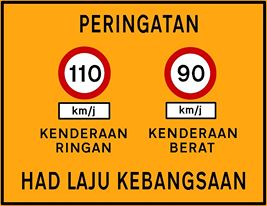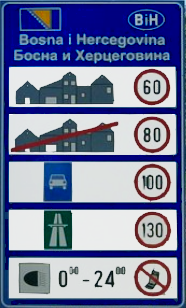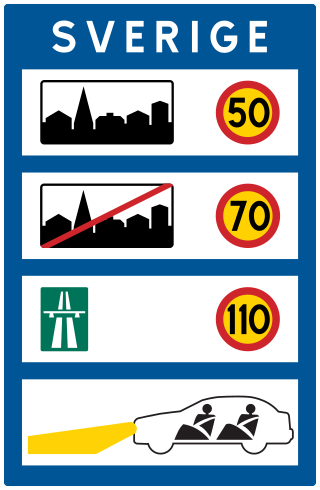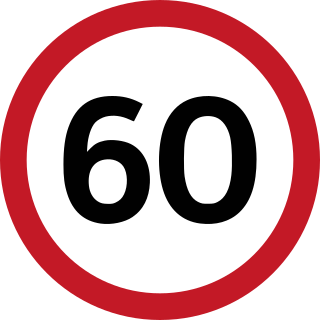
Speed limits on road traffic, as used in most countries, set the legal maximum speed at which vehicles may travel on a given stretch of road. Speed limits are generally indicated on a traffic sign reflecting the maximum permitted speed, expressed as kilometres per hour (km/h) or miles per hour (mph) or both. Speed limits are commonly set by the legislative bodies of national or provincial governments and enforced by national or regional police and judicial authorities. Speed limits may also be variable, or in some places nonexistent, such as on most of the Autobahnen in Germany.

A limited-access road, known by various terms worldwide, including limited-access highway, dual-carriageway, expressway, and partial controlled-access highway, is a highway or arterial road for high-speed traffic which has many or most characteristics of a controlled-access highway, including limited or no access to adjacent property, some degree of separation of opposing traffic flow, use of grade separated interchanges to some extent, prohibition of slow modes of transport, such as bicycles, horse-drawn vehicles or ridden horses, or self-propelled agricultural machines; and very few or no intersecting cross-streets or level crossings. The degree of isolation from local traffic allowed varies between countries and regions. The precise definition of these terms varies by jurisdiction.

In the United States, speed limits are set by each state or territory. States have also allowed counties and municipalities to enact typically lower limits. Highway speed limits can range from an urban low of 25 mph (40 km/h) to a rural high of 85 mph (137 km/h). Speed limits are typically posted in increments of five miles per hour (8 km/h). Some states have lower limits for trucks, some also have night and/or minimum speed limits.

Road speed limits in Ireland apply on all public roads in the state. These are signposted and legislated for in kilometres per hour. Speed limits are demarcated by regulatory road signs. These consist of white circular signs with a red outline. Speed limits are marked in black with "km/h" below the speed limit. Smaller "repeater" speed limit signs are used along stretches of road where there is no change in speed limit, in order to remind motorists currently on the road and to inform traffic merging from junctions that a certain speed limit applies.
Speed limits in Australia range from 5 km/h (3.1 mph) shared zones to 130 km/h (81 mph). Speed limit signage is in km/h since metrication on 1 July 1974. All speed limits, with the sole exception of the South Australian school and roadworks zones, which are signposted at 25 km/h, are multiples of 10 km/h – the last digit in all speed signs is zero. Speed limits are set by state and territory legislation albeit with co-ordination and discussion between governments.

The National Maximum Speed Limit (NMSL) was a provision of the federal government of the United States 1974 Emergency Highway Energy Conservation Act that effectively prohibited speed limits higher than 55 miles per hour (89 km/h). The limit was increased to 65 miles per hour (105 km/h) in 1987. It was drafted in response to oil price spikes and supply disruptions during the 1973 oil crisis. Even after fuel costs began to decrease over time the law would remain in place until 1995 as proponents claimed it reduced traffic fatalities.

Had Laju Kebangsaan (National Speed Limits) is a set of speed limits applicable on Malaysian expressways, federal roads, state roads and municipal roads. The National Speed Limits was enforced on 1 February 1989 following the National Speed Limit Orders 1989 (Perintah Had Laju Kebangsaan 1989). Like any other countries in the world, failing to obey the speed limit on Malaysian roads and expressways is an offence as subject to Malaysian Road Safety Act 1987, which can be fined up to RM300, depending on the difference between the speed limit and the driven speed.

A speed limit is the limit of speed allowed by law for road vehicles, usually the maximum speed allowed. Occasionally, there is a minimum speed limit. Advisory speed limits also exist, which are recommended but not mandatory speeds. Speed limits are commonly set by the legislative bodies of national or local governments.
Canadian speed limits are set by different levels of government, depending on the jurisdiction under which the road falls, resulting in differences from province to province. The limits have been posted in kilometres per hour (km/h) since September 1, 1977. Before then, when Canada used Imperial units, speed limits were in miles per hour (mph).

Road speed limits in the United Kingdom are used to define the maximum legal speed for vehicles using public roads in the UK.

Speed limits in Germany are set by the federal government. All limits are multiples of 10 km/h. There are two default speed limits: 50 km/h (31 mph) inside built-up areas and 100 km/h (62 mph) outside built-up areas. While parts of the autobahns and many other freeway-style highways have posted limits up to 130 km/h (81 mph) based on accident experience, congestion and other factors, many rural sections have no general speed limit for some classes of vehicles. The Road Traffic Regulations (StVO) section on speed begins with the requirement which may be rendered in English:
Any person driving a vehicle may only drive so fast that the car is under control. Speeds must be adapted to the road, traffic, visibility and weather conditions as well as the personal skills and characteristics of the vehicle and load.

Four general speed limits apply on roads in Bosnia and Herzegovina:

Sweden has speed limits ranging from 30 km/h to 120 km/h, where 30, 40, 50, 60 and 70 km/h are used within towns and cities. Outside schools and hospitals the limit is often 30 km/h. 70, 80, 90 and 100 km/h are mainly used outside built-up areas where the speed limit depends on the standard and safety of the road. 90 and 100 km/h are used mainly on roads with separated lanes, however local exceptions may apply, mainly in northern Sweden, where 100 km/h (62 mph) is legal on roads with no separated lanes and where the standard of the road often is poor. The main reason for setting 100 km/h on these roads is because of their high importance to the region. Earlier it was permitted to drive 110 km/h (68 mph) on these roads but due to the poor standards the speed limit was lowered to 100 km/h in 2008.

The default speed limits in the Netherlands are 50 km/h (31 mph) inside built-up areas, 80 km/h (50 mph) outside built-up areas, 100 km/h (62 mph) on expressways (autowegen), and, as of 16 March 2020, 100 km/h from 6:00 to 19:00 and 130 km/h from 19:00 to 6:00 on motorways (autosnelwegen).

Statutory speed limit in Japan defaults to 100 km/h (62 mph) for national expressways, 30 km/h (19 mph) for undivided roads without a center line from September 1, 2026 and 60 km/h (37 mph) for any other roads, unless otherwise posted. Urban two-way streets are usually zoned at 40 km/h (25 mph) or less.

Speed limits in the Philippines are specified in Republic Act No. 4136, or the Land Transportation and Traffic Code of the Philippines, which took effect on its approval on June 20, 1964. The act covers a number of areas other areas than speed limits, and was amended regarding some of those areas by Republic Act No. 10930, which was approved on August 2, 2017.

General speed limits in New Zealand are set by the New Zealand government. The speed limit in each location is indicated on a nearby traffic sign or by the presence of street lighting. The limits have been posted in kilometres per hour (km/h) since 1974. Before then, when New Zealand used imperial units, maximum speeds were displayed in miles per hour (mph). Today, limits range from 10 km/h (6.2 mph) to 110 km/h (68 mph); in urban areas the default speed limit is 50 km/h (31 mph).

Four general speed limits apply on roads in Serbia:

Speed limits in the United States vary depending on jurisdiction. Rural freeway speed limits of 70 to 80 mph are common in the Western United States, while such highways are typically posted at 65 or 70 mph in the Eastern United States. States may also set separate speed limits for trucks and night travel along with minimum speed limits. The highest speed limit in the country is 85 mph (137 km/h), which is posted on a single stretch of tollway in exurban areas outside Austin, Texas. The lowest maximum speed limit in the country is 30 miles per hour (48 km/h) in American Samoa.

As per Lithuanian traffic act §15, the general maximum speed limits in Lithuania are:

















